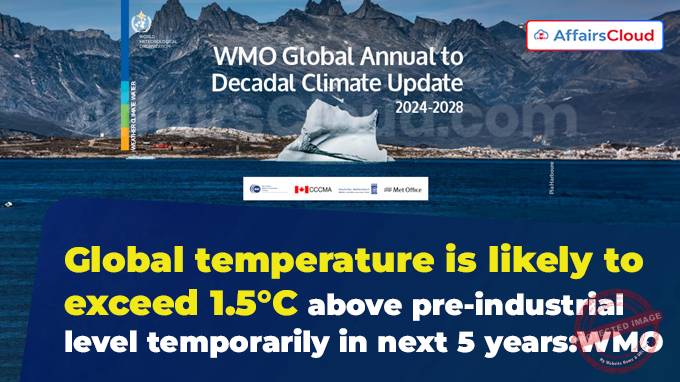 According to the World Meteorological Organization (WMO) annual report, “WMO Global Annual to Decadal Climate Update (2024-2028)”, there is an 80% chance that the average global temperature will temporarily exceed 1.5°C above pre-industrial levels for at least one of the next 5 years (2024-2028).
According to the World Meteorological Organization (WMO) annual report, “WMO Global Annual to Decadal Climate Update (2024-2028)”, there is an 80% chance that the average global temperature will temporarily exceed 1.5°C above pre-industrial levels for at least one of the next 5 years (2024-2028).
- Predictions of the global mean near-surface temperature indicate a range of 1.1 degree Celsius (°C) to 1.9°C above the 1850-1900 baseline for each year from 2024 to 2028.
- There’s an 86% chance of at least one of these years setting a new temperature record, potentially exceeding the current warmest year, 2023.
Note: As per the WMO State of the Global Climate 2023, the global average temperature in 2023 was 1.45°C above pre-industrial levels. It is the highest on record due to climate warming and the El Niño event, which is now disappearing.
About the Report:
i.The report offers critical insights into the global annual-to-decadal climate projections produced by the WMO-designated Global Producing Centres and other contributing centers.
ii.The update is produced by the United Kingdom’s (UK) Met Office, the WMO Lead Centre for Annual to Decadal Climate Prediction.
iii.This report warns about our closeness to breaching climate goals set in the Paris Agreement, which refers to long-term temperature increases over decades, not over 1 to 5 years.
- Under the Paris Agreement, countries agreed to keep the long-term global average surface temperature well below 2°C above pre-industrial levels and pursue efforts to limit the temperature to 1.5°C by the end of this century.
Note: Short-term (annual) warming doesn’t equate to a permanent breach of the lower 1.5°C Paris Agreement goal.
Highlights:
i.The chance of 1.5°C exceedance (above the pre-industrial era) over the 2024-2028 period rises to 47%.
- It is an increase from the 32% of the 2023 report for the 2023-2027 period.
ii.The chance of at least one year exceeding 1.5°C has risen from nearly zero in 2015 to 80% today.
- There was a 20% chance of exceedance, for the years between 2017 and 2021, and this increased to a 66% chance between 2023 and 2027.
iii.WMO warns of the increasing frequency of temporary breaches of the 1.5°C level.
iv.Although temporary, these breaches do not indicate a permanent failure to meet the 1.5°C goal, which refers to long-term warming.
v.Current warming already leads to extreme heatwaves, heavy rainfall, droughts, and melting ice; accelerating sea level rise and ocean heating, and biodiversity loss.
Key Messages:
i.Arctic warming over the next 5 extended winters (November to March) is predicted to be more than 3 times the global mean temperature increase compared to the 1991-2020 average.
ii.Sea-ice concentration in the Barents Sea, Bering Sea, and Sea of Okhotsk is expected to reduce further between March 2024 and 2028.
About World Meteorological Organization (WMO):
WMO is a specialized agency of the United Nations (UN) responsible for promoting international cooperation in atmospheric science and meteorology.
Secretary-General– Professor Celeste Saulo
Headquarters– Geneva, Switzerland
Established- 1950




